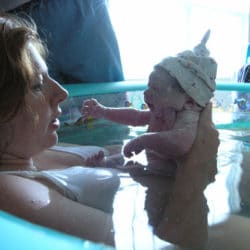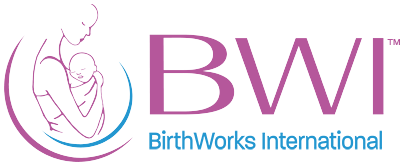Water birth has many wonderful benefits and is safe (for most mothers and babies*). There is a strong connection between mother’s fear, feeling safe in birth, the impact and importance of birth place, and how to assure love pervades the birthing context (learn more here). Water birth helps all of these very significant things.
When considering both the short-term and long-term benefits of water birth, they are congruent - evidence shows the most early inter-personal experiences the baby and mother have with water birth positively impact both their brains, hormones, bonding, wellness, health, and happiness. Water birth gives mothers control, and they feel less pain. Evidence shows that babies born in the water have better health outcomes!
What is water birth?
Also known as “gentle birth”, it is a method that encourages labor and delivery in a warm water tub (like a deep bath or birthing pool). The theory is that birth takes place in an environment similar to the warm, protected, fluidy space of the womb. Water helps moms feel comfort, peace, and relaxation, and is less traumatic for babies. Women labor in the water and can get out to birth (then it is called “birth immersion”), and some stay in to birth in the water (with support from a trained professional).
Why would someone consider a water birth?
There are physiological and anatomical reasons. Laboring in water relaxes and offers pain relief. The second stage of labor is easier for the mother because the baby drives the process - due to “neuro-programming in the baby’s brain combined with the powerful erectile forces of the uterus”. Mom can relax versus pushing, which means less pain and better outcomes for her and her baby.
There are deeper reasons to choose water birth. The water feels like a sanctuary to mothers, so they feel safe and peaceful. Water birth is a loving way to meet a baby and bring them into the world. In BWI, we teach that fear and love can not coexist. If a mother trusts herself to go into the water to birth her baby, she is embodying trust and faith in her own ability to connect to the baby and give birth. As explained by Barbara Harper of Waterbirth International, it is “easier for mom and better for babies”.
A more important question is - why not give birth in water?! There are so many benefits. Here are just some:
Water birth provides benefits to the newborn
- More space for optimal fetal positioning - room to move
- Transition “from the womb to the room” is gentle
- Sensory experience for the mind, neurology and somatic (body nerves)
- Skin-to-skin contact that is immediate and uninterrupted
- Primitive reflexes can be completely expressed
- No one needs to put their hands on baby’s head or pull them out
- Delayed cord clamping is possible - the cord is close and accessible
- Babies get exposure to build a healthy microbiome (also vernix stays on them)
- Fewer newborth hospital transfers (from home), disease or hospitalization
- Less interventions (or trauma) to mom means happier baby
Water birth benefits the birthing mother
- Pain is reduced
- Reduces use of pain medication
- Water relieves pressure and supports the body
- More oxytocin flow, which can shorten labor
- Bouyancy of water means less pressure/space for joints and organs
- She can TRUST in many ways
- Stepping into water means believing in her own capability, wisdom and the normalcy of birth
- Her movements (rocking herself in the water) calms her parasympathetic nervous system - she tunes into knowing “her body is the vehicle and her baby the driver”.
- It is a relaxed and easy way to birth, so she feels less pain (impacting her hormones - less stress-related ones and more pain inhibitors and positive hormones that help with labor and birth)
- Shifting the “Fear-Tension-Pain” Cycle means “Comfort-Peace-Relaxation”
- More control - especially in labor’s second stage
- Buoyancy of water encourages a laboring woman's body to move
- Mother is “captain of the ship” to make her own decisions to shift positions - she rarely needs help
- Her weight is off her sacrum and it is not immobilized (it would be if lying supine in bed - we know this from the work of Jean Sutton on BWI Board of Advisors.)
- It might feel good for mom to go up on her toes (which is easy in water) which helps move the pelvis forward
- More optimal pelvic positioning! (taught in BWI trainings)
- Movement means easier position changes, so baby descends
- Moms can hold positions with less fatigue
- Forward pelvis - allows baby to pass under the pubic bone
- Even leaning back on the side of the pool, the buoyancy helps keep the sacrum free (if out of water, a free sacrum happens only in forward pelvis positions)
- Trusting her uterus!
- As she releases her bottom, her body “lets baby out” (vs. pushing)
- Her urge to “push” gently at station 1-2 will be strong
- “Mother-guided pushing” gives best synchrony with “maximal uterine effort”
- Less stress on perineum and less/minor perineal tears
- Medical concerns and needs are in the background
- Less or no medication for induction or pain, less epidurals
- No episiotomy needed
- Perinatal trauma less frequent and less severe
- Less postpartum bleeding - warmth of water decreases dilation
- Less maternal hemorrhage, infection, hospital transfers/hospitalizations
- Satisfaction with birth!
- Mom will feel good about herself and her capabilities
- Labors are shorter on average and higher rate of normal vaginal birth
- Provider can be hands off mostly
- Less medications and interventions mean a healthier, more alert baby
- Ideal connection and bond to newborn - it is immediate and uninterrupted
- A positive birth story means positive mental wellness (going into newborn care and parenting)

Water birth even benefits the provider - but they have to understand the value!
- Reduces anxiety and risks to mothers and babies
- Less maternal and/or infant trauma or loss
- No need for narcotics (less pain medication)
- Minimizes (or eliminates) interventions (and risk of cascading interventions)
- Autonomy for women - this comes to those who gently receive and guide their baby to the surface of the water - and better outcomes
- Better outcomes for baby’s health and wellness, so less concerns
- More job satisfaction (for tuned-in providers who prefer to trust birth)
At what point in labor should a woman go into the water for a water birth?
During labor, the mother can choose to go in the water any time they want, not just during active labor. Mothers can also get in and out however they desire. (The term water immersion describes using water early in labor, then getting out to birth the baby.) People may ask - can laboring in water slow down labor? The answer is this - true labor will not slow down in the water, if a mother feels safe there. (If it does slow down, she may feel nervous - so give her time and the option to get out any time she prefers.) The warm water feels comforting and can provide relief. As contractions increase in frequency and intensity, water helps. Staying in through labor into birth is lovely for those who want water birth. (The water must be kept at a comfortable temperature - close to mother’s body temperature - around 92-100℉ (32-38℃).
During pregnancy, entering the water for relaxation, to meditate, or to exercise are all lovely times to start to bond with the baby in water. This can include taking baths at home, or prenatal classes in a swimming pool, or aqua therapy. Mother can purposefully put her hands on her belly to connect to the baby, and maybe talk or sing. That will set her for familiarity to consciously be with the baby in the water later to labor/birth.
Who should have a water birth?
Most healthy women can choose to labor and/or birth in water. It is ideal they are between 37 to 41 weeks of pregnancy, and there are no prior health concerns for them or their baby. If labor is induced, or mother wants pain medicine, a spinal or an epidural - water birth is not an option. Parents should always discuss their birth wishes with a midwife and/or health care provider, deserve informed consent, and be able to weigh the risks and benefits of each choice…
Who should not have a water birth?
There are concerns that preclude water birth. Water birth is not recommended for mothers:
- doing vaginal birth after a cesarean (VBAC
- with multiple pregnancy (twins, etc)
- who have serious infections, like active infection (like Herpes)
- have low iron levels (could mean feel weak, dizzy o light-headed)
- inability to physically get in and out of the water tub safely (fitness level and/or BMI over 40 may be a guideline to consider)
Concerns about infant health which preclude water birth include:
- baby is in a breech position
- pre-term babies (<37 weeks)
- fetal abnormalities (that increase risk, such as placenta previa)
- if baby passed meconium (before or during labor)
What are the best ways to support mothers during water birth?
Hold the space
As always, hold space for the mother. Water birth adds a layer of magic to helping the woman tune in to her baby (in her own space) that is lighter and more free. You can guide her to find the power within herself and relax into the experience. In the water, she is in control. You can respect that and hold that for others who are there too.
Ways to support her include – help maintain quiet, minimize distractions, and observe silently (research shows another woman in the room just focused on support does help labor progress). Just like at other births, doulas can be attentive to mother’s needs - speak to her, sing to her, remind her to relax her hands (this is a technique we teach in BWI workshops), or to breathe through contractions. Offering massage, or pressure on her low back - as she wants - and definitely suggesting position changes are wonderful support!
Educate
During childbirth education classes or prenatal appointments, it’s good to discuss the benefits. A wonderful way to educate is to share that for the second stage mother’s job is just to “let the baby out” - as pushing is not always needed and sometimes harmful to mother and baby. During labor, doulas can remind her of this, if useful. Mom’s and baby’s heart rates can be monitored in the water too. Also, depending on the circumstances, there may be a need for others to help the mother gently bring the very wet baby to the surface. You can also guide suggestions for the baby to be supported on mom’s belly or chest to do their instinctive behaviors. (Being with mother skin-to-skin assures their body temperature is regulated by their mother.) Also, when she is ready to get out of the water, mother will need assistance.
When they are born, the baby’s head should not be touched. People may ask when the baby comes - how long they can be in the water? One way to think about it is to count to ten (our perception may be different, but the baby is getting what it needs). The midwife or healthcare provider can check the baby's pulse in the cord. The baby should be brought to the surface very gently (this helps assure the cord is safe and intact) and put directly on the mother's chest. [In any delivery, umbilical cord snapping (avulsion) is a potential risk, so extra attention needs to be paid to this in water birth. If it happens, the midwife or medical provider there can manage quickly (immediate cord clamping the cord) to avoid adverse health effects.] Once their face is in the air, the baby’s head should not go back under (to assure they do not breathe in bath water). To begin breathing air, babies born in the water just need time and our patience, as they are often slower to start respiration (think another 30 seconds comparatively). Babies are stimulated to switch from water circulation to fetal circulation when they feel air on their faces. Their blinking eyes and first swallowing (then spitting) are good signs.
Inspire Mothers to Consider Water Birth
You can share all this information with mothers (and their partners) and inspire them with the idea that if water birth feels safe - they can do it. There are many studies on the benefits, but varied hospitals may not offer or allow it - so mothers seeking water birth should ask their provider and may need to consider home birth or a birth center instead. This choice to birth in water is one about “letting the baby out versus getting the baby out”! Mothers deserve to relax in a comfortable sanctuary when they give birth. Their babies deserve a gentle birth and the most loving welcome into the world!
__________________________________
BirthWorks wants to thank Barbara Harper for her deep wisdom and global impact to grow understanding and education about the value of water birth. We are proud to have Barbara on our BWI Board of Advisors! [Much of the material shared in this blog was inspired by a talk on water birth that was part of the February 2024 Microbiome conference.] Barbara is an author, educator, midwife and internationally recognized expert on the use of warm water immersion for labor and birth. In 1988, she founded Waterbirth International after researching water immersion as a gentle birth option for mother and child. Since then, she has educated people in over 60 countries on the benefits.
For a review of evidence-based research on water birth, refer to this excellent study by Dr. Rebecca Dekker of Evidence-Based Birth.



